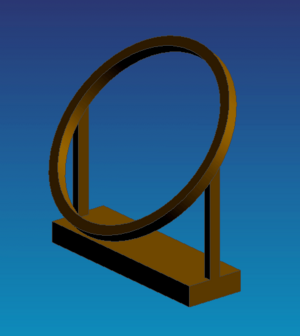Equatorial ring facts for kids
An equatorial ring was a special tool used long ago to figure out the exact time of the spring and autumn equinoxes. Think of it like an ancient clock for the sky! People in places like Alexandria and Rhodes used these rings, often near temples, to help them keep track of the calendar.
Contents
How Did This Ancient Tool Work?
Finding the Equinox
Imagine a ring standing straight up, pointing east and west, right on the Earth's equator. During the equinoxes, the Sun rises exactly in the east. It then travels directly overhead (this point is called the zenith) and sets exactly in the west.
Throughout the day on an equinox, the top part of the ring casts a shadow. This shadow perfectly covers the bottom half of the ring. It's like the ring is shading itself!
What Happens on Other Days?
On days that are not an equinox, the Sun's path is different. It passes either to the north or south of the ring. This means the Sun will light up the bottom half of the ring instead of casting a shadow on it. So, if the bottom half was lit, they knew it wasn't an equinox.
Adjusting for Location
Most places are not right on the Earth's equator. For these locations, the ring just needed to be tilted at the correct angle. This made sure it still lined up with the Sun's path during the equinox. If you were at the Earth's poles, the ring would lie flat, or horizontal.
What Did They Look Like?
Equatorial rings were usually about one to two cubits across. A cubit was an old measurement, roughly 45cm to 90cm (about 1.5 to 3 feet).
The Sun isn't a tiny point of light, so the shadow it cast wasn't perfectly sharp. The shadow on the bottom half of the ring was a little bit narrower than the ring itself. By carefully watching until the shadow was exactly in the middle of the ring, they could tell the exact moment of the equinox. They could usually figure it out within about an hour!
If the equinox happened at night, or if the sky was cloudy, they couldn't see the shadow. In these cases, they would use measurements from the days before and after to guess the exact time.
Challenges with Equatorial Rings
One big problem with equatorial rings was that they had to be set up very, very carefully. If they weren't perfectly aligned, they could give wrong measurements.
For example, Ptolemy, a famous ancient scientist, wrote about a ring in Alexandria. It had moved a little bit, which made it seem like the equinox happened twice on the same day!
Another issue was atmospheric refraction. This is when light bends as it passes through the Earth's air. This bending can make the Sun appear higher than it actually is, especially when it's close to the horizon. This could also cause false readings.
Where Else Can You Find Them?
You might also see equatorial rings as part of other old astronomical tools. They were sometimes included on armillary spheres, which are models of the celestial sphere. They also appeared on special types of sundials called equatorial sundials.


